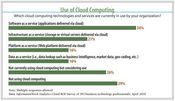Virtualization software from Amazon EC2 designers aims to operate across multiple virtual machine formats and internal and external clouds.

| |
| |
Nimbula offered a quick view of Director, "a cloud operating system for the real world" at an event Monday for press and analysts near VMware's VMworld in San Francisco.
It was a gambit by Nimbula's founders, Chris Pinkham and Willem van Bijon, who were also the original designers of Amazon's EC2 cloud. VMware often describes its evolving virtualization software as a data center operating system. Pinkham and Bijon are trying to steer Nimbula so future customers won't need to select a particular virtual machine format.
For that matter, they'd like Director to have one set of APIs that could be used to link internal cloud services to similar external cloud services, regardless of who the provider might be. They want the builder of an internal cloud to be able to select Rackspace or Amazon's EC2 or Terremark services as they see fit, without knowing very much about the differing APIs involved.
Director will also have the smarts to take a workload, a combination of operating system and application, cast in a particular virtual machine file format, and recast it for delivery to the target cloud, they said. Amazon uses a proprietary version of Xen, called the Amazon Machine Image. VMware has been supporting the creation of cloud suppliers, such as AT&T and Verizon Business, who use its ESX Server preferred format.
Director "will install on bare metal. We don't assume any operating system or hypervisor," said Pinkham. Once installed, Director will be able to work with any x86 operating system, including Windows Server and Linux, and any of several hypervisors. The beta of Nimbula's director recognizes KVM and Xen, two open source formats. ESX Server is next on the list says, Pinkham.
Their cloud operating system is in a private beta with several customers, soon to enter a public beta but Pinkham acknowledged, "I can't say when." Likewise, the appearance of a generally available product is slated for later this fall, with no date set.
Once it becomes available, it will include automated resource discovery. If servers or storage are added to the cluster, Director will find them. "If you add a new rack, Director will find it. It will virally adapt to new resources," said Pinkham. Director itself is intended to be distributed across several nodes in a cluster and will scale from managing a minimum of three nodes up to thousands of nodes.
| |
| |
It will include a "fine grained" user identification and authorization system that makes use of Microsoft Active Directories and LDAP-based identity management directories. For each action that a user attempts to take, Director will check and see whether he has permission to take it. An already identified user might be initially authorized to delve into a product and parts database. When he later attempts to check into the customer database for those parts, Director will run another check to the appropriate director to see whether he's authorized to go in there as well.
"Every action against an object is policy based and permission tested," said Pinkham, as opposed to a user being recognized and then assigned one permission level based on his role. It may be that managers are allowed to view customer information in one part of the quarter but not another. The permissions-based approach keeps a constant check at work on user actions, he said.
Likewise, policies can be set on which virtual machines may talk to each other in a multi-tenant environment.
Director will also enforce identities, authorizations, and policies set for the internal, enterprise environment on a workload if it moves beyond the enterprise perimeter into a public cloud. Nimbula is trying to enable the working together of public and private clouds, with Amazon's EC2 used as the public host in Monday's demonstration.
Demonstration engineer Kuyper Hoffman started a server in EC2 and illustrated that it was working through the Director control panel. The amount of information on the EC2 instance was limited and the initiator of workload sharing between an enterprise cloud and EC2 would have to eventually move into EC2's control panel, he conceded. But Director can do the mapping between the two that enables the workload move, he said.
The set of servers that Nimbula officials used to demonstrate their cloud operating system was mixed four- and eight-core Intel rack mount servers. "Back in the lab, we have a mix of AMD and Intel," noted Hoffman.
He illustrated how a user might configure four Web servers, each to be launched on a different node in the EC2 cloud to ensure continued operation. At the same time the user might need three application servers with 10-Gb Ethernet, and three database servers with both 10-Gb Ethernet and Fibre Channel and double the RAM of the web servers. The set could be launched in EC2 together instead of each server being configured separately through the Amazon EC2 console, Hoffman said.
"The virtual machines can come from the same base image. We have a mechanism to translate them from the format of one cloud to another," he said during the demonstration.
Nimbula was founded in 2009 and has a fresh $15 million in venture capital funding, after a previous $5 million investment. It has expanded its ranks from 19 to 22 people in the course of the last two weeks; it is currently looking for more employees. It will move out of Sequoia Capital offices into its own space in Mountain View, Calif., in two weeks. "I just signed the lease and ordered some office furniture," Pinkham said before the event got underway.
About the Author(s)
You May Also Like










